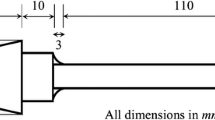Abstract
The aim of this investigation is to develop a model to predict low cycle fatigue (LCF) life of Al–Si–Mg based alloys and establish a correlation between some important processing parameters and LCF life of the investigated alloy. A most popular statistical analysis tool known as artificial neural network model based on multilayer feedforward neural network has been used in this prediction approach. For accurate prediction of fatigue life, a large dataset has been created by collecting the input–output pairs of the experimental results from existing literature. The effects of various processing parameters such as Si content, Mg content, heat treatments, etc. on LCF life have also been predicted using the created network. The predicted results indicate that the fatigue life increases with increase in both Si and Mg content in the alloy; the results are in accordance with some experimental observations available in literature. It is also predicted that fatigue life, which increases with decreasing strain amplitude, was shifted towards the higher number of cycles to failure under T6 heat treatment condition than under both T5 and some modified T6 heat treatment conditions. Similar conclusions are also drawn for experimental results as reported in some literature. The life predictive capability of the created network shows a good acceptability as most of the predicted results lies within a factor of 2.





Similar content being viewed by others
References
Sharma S R, Ma Z Y and Mishra R S, Scr Mater 51 (2004) 237.
Li J, Xie J, Wang W and Wei S, Mater Sci Forum 561–565 (2007) 147.
Ammar H R, Samuel A M and Samuel F H, Mater Sci Eng A 473 (2008) 65.
Song J X, Qiu H G, Bing L, Jie F S and Hao Z M, Trans Nonferrous Met Soc China 21 (2011) 443.
Haykin S, Neural Networks: a Comprehensive Foundation, Upper Saddle River, Prentice Hall, NJ, USA (1999).
Donelan P, Mater Sci Technol 16 (2000) 261.
Rumelhart D E, Hinton G E and Williams R J, in Parallel Distributed Processing: Explorations in the Microstructure of Cognition, (eds) Rumelhart D E, McClelland J L and the PDP Research Group, MIT Press, Cambridge, MA, USA (1986) p. 318.
Emami A R, Begum S, Chen D L, Skszek T, Niu X P, Zhang Y and Gabbianelli F, Mater Sci Eng A 516 (2009) 31.
Borrego L P, Abreu L M, Costa J M and Ferreira J M, Eng Fail Anal 11 (2004) 715.
Fatemi A, Plaseied A, Khosrovaneh A K and Tanner D, Int J Fatigue 27 (2005) 1040.
Song M and Ran M, Mater Charact 62 (2011) 367.
Heat Treating of Aluminum Alloys, ASM Desk Editions Online, ASM International (2001).
Srinivasan V S, Valsan M, Rao K B S, Mannan S L and Raj B, Int J Fatigue 25 (2003) 1327.
Malinov S, Sha W and McKeown J J, Comput Mater Sci 21 (2001) 375.
Lados D A and Apelian D, Mater Sci Eng A 385 (2004) 200.
Dieter G E, Mechanical Metallurgy, McGraw-Hill Company, UK (1988).
Salleh M S, Omar M Z and Syarif J, J Alloys Compd 621 (2015) 121.
Cerri E and Nenna S, Mater Sci Eng A 355 (2003) 160.
Author information
Authors and Affiliations
Corresponding author
Rights and permissions
About this article
Cite this article
Mishra, S.K., Brahma, A. & Dutta, K. Low Cycle Fatigue Life Prediction of Al–Si–Mg Alloy Using Artificial Neural Network Approach. Trans Indian Inst Met 69, 597–602 (2016). https://doi.org/10.1007/s12666-015-0785-4
Received:
Accepted:
Published:
Issue Date:
DOI: https://doi.org/10.1007/s12666-015-0785-4




